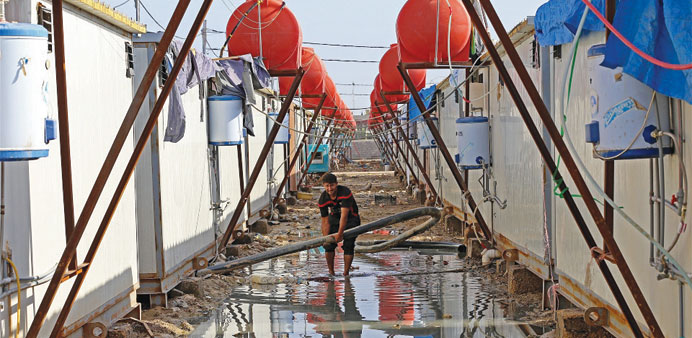A man fixes water pipes while standing in floodwater behind a set of shelters in Nabi Younis camp in Nahrawan, a suburb of Baghdad. Heavy rain in Iraq in late October inundated several areas of the country considered vulnerable to the spread of cholera. Extensive flooding near Baghdad caused sewage systems to overflow, impacting 65,000 residents in camps for people displaced by Iraq’s ongoing violence.
By Philippa Garson/Paris
As weather becomes more extreme and erratic, the scramble for a bigger and better set of tools to cope with the fallout is on.
“Science is quite clear that we’re experiencing more frequent extremes. While we’re sure about some of the impacts and extremes, we’re also getting more surprises,” Maarten van Aalst, director of the Red Cross/Red Crescent Climate Centre told IRIN on the sidelines of COP21. “And as the Earth keeps warming, there will be more of these surprises.”
While it’s still impossible to predict exactly what is around the corner, the one constant is uncertainty itself. For vulnerable people and farmers, this can be deadly. “One of the most valuable assets for farmers is (to know) what to plant and when to plant, and this is being taken away,” said Van Aalst.
But for both vulnerable rural and swelling urban populations who are buffeted by increasing floods, droughts and other extreme weather events - and for the humanitarian sector trying to help out - there is a growing array of proactive measures that can help save lives, crops and homes.
At the forefront of this push is the International Federation of Red Cross and Red Crescent Societies, which has piloted a new mechanism - Forecast Based Financing - that unlocks funds for humanitarian response before a disaster happens.
The aim is for action to be automatically triggered when a certain level of risk is reached. Used for the first time in Uganda last month, the Red Cross was able to distribute items such as jerry cans and water purification tablets to prevent the spread of cholera before the flooding became a problem. The IFRC is piloting several similar programmes in other parts of Uganda, Togo and Zambia, where the World Bank is also involved in a pilot project to help communities respond to scientific warnings.
However, Van Aalst is critical of the lack of funding available for reducing risk. “It’s still very difficult to mobilise resources when you’re not yet dealing with an actual humanitarian disaster,” he said.
But many other high- and low-tech innovations - from advanced satellite systems like drones and biometric scanners, to cell phones, to basic river poles and gauges, to planting more resilient crops - are helping people prepare for the unexpected.
Maxx Dilley, director of climate prediction and adaptation for the World Meteorological Organisation, discerns changes in the way people are adapting to cope with the additional stresses of El Nino.
“Today, we have a lot more information about how El Nino is torquing the climate in different directions.”
Dilley told IRIN that people are talking about it and trying to prepare for it in a way that is very different from the last El Nino in 1997-1998.
But communicating effective short- and long-term strategies to the people directly affected by climate change poses one of the greatest challenges. Much of the information is scientific and complex and doesn’t always get to where it’s needed.
“The science is getting much better on the climate side and the remote-sensing side,” explained Van Aalst. “Billions of dollars are being spent gathering information that is often very scientific and complex. But not only is most of it not very useful, it doesn’t find its way in the right format to the people who need it.”
The objective must always be for the most vulnerable people to be able to use it, but for this to happen, they have to trust the information.
“We need to ask ourselves, ‘Do people first understand the warning and are they able to act on it?’” said Van Aalst. Going the last mile - getting the message to the local user - is the crucial step that is often being ignored, he added.
When information is imparted in a top-down way, it can elicit suspicion. The IFRC uses a network of local volunteers in its pilots to spread the messages. “It’s far more effective when information is passed on by peers than from an abstract agency like Nasa,” noted Van Aalst.
Another big challenge is the poor state of meteorological systems in many developing countries, where such equipment is often low on the list of funding priorities. Often these systems were installed in colonial days and have not been well maintained. Many cash-strapped countries sell their weather data to generate revenue rather than make it freely available to the public.
The African Development Bank has made a $600bn investment over the coming years to beef up the meteorological systems in 15 West African countries.
According to the Lima to Paris Action Agenda, there has been significant progress on developing early warning systems for more than 50 of the poorest countries, as well as access to insurance for 400mn people who stand to be affected over the next five years.
UN Global Pulse - an initiative of UN Secretary-General Ban Ki-moon to harness data for public good - brought players in the private sector and policy arena together at COP21 to explore how data science can be used to improve action around climate adaptation and mitigation.
The campaign echoed other loud calls in Paris for the private sector to come on board to create and fund ways of combating and coping with climate change.
The same data that private companies analyse to understand the habits of their consumers could be used to find out how climate change impacts on human behaviour, for example, and what interventions could take place for early warning systems.-IRIN

